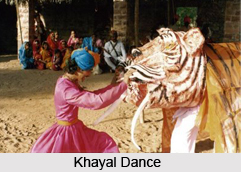 Khayal dance has acquired a prominent place in Rajasthan. It is one folk dance in Rajasthan that has been holding its place among the other dances. This dance is performed by the Bhawai caste. Thought to have been originated from the Jats, this Bhawai caste performs the Khayal dance on heredity basis. The themes for the dance are derived from the great Hindu epics i.e. the Ramayana and the Mahabharata. They enact these dance-dramas and have numerous ballets; some of which are humorous and depict the comic characters of `baniyas`, barbers and moneylenders with bitterest satires. Among the various items the following have been in vogue like the "Bohara-Bohari", "Surdas", "Lodi-Badi", "Dokari", "Shankari", "Bikaji", etc.
Khayal dance has acquired a prominent place in Rajasthan. It is one folk dance in Rajasthan that has been holding its place among the other dances. This dance is performed by the Bhawai caste. Thought to have been originated from the Jats, this Bhawai caste performs the Khayal dance on heredity basis. The themes for the dance are derived from the great Hindu epics i.e. the Ramayana and the Mahabharata. They enact these dance-dramas and have numerous ballets; some of which are humorous and depict the comic characters of `baniyas`, barbers and moneylenders with bitterest satires. Among the various items the following have been in vogue like the "Bohara-Bohari", "Surdas", "Lodi-Badi", "Dokari", "Shankari", "Bikaji", etc.
History of Khayal Dance
It is believed that during the 16th century, the Jats only practiced this folk dance. Sometime later, the Bhawai tribes picked it up from the Jats and continued till date.
Performance and Aim of Khayal Dance
Khayal dance is very artistic in nature. So, the Bhawai men who perform this dance need to be very good at narration and mimicry. Women do not participate in Bhawai dances. No matter what character the participants enact, they are required to imitate that character to the maximum extent possible.
The performance of Khayal dance is greatly influenced by the epics of Ramayana and Mahabharata. Through this dance drama, the performers aim to educate the society about the story of the great gods and the justice they provided. It also aspires to educate the people about the significance of being good to others, being helpful to others, not hurting others and always following the path of righteousness. The Khayal dance also tries to better the society by highlighting various social issues through its performance.
The Khayal dance is full of mockery, humour and irony. However, the ambition is not just to make fun of others rather it acts as an eye opener for those who can"t fathom the cunning acts of the others.
Musical Instruments of Khayal Dance
This folk dance is mainly accompanied by percussion instruments like drums, dholaks, nagaras. Sometimes stringed instruments like violin too accompanies Khayal dance.



















